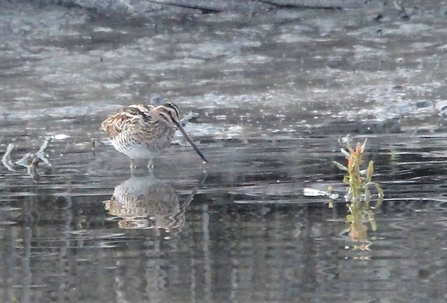
Snipe credit Chris Farthing
Whitethroat credit Chris Farthing

Snipe credit Chris Farthing
Cold weather and northerly winds for most of April meant our winter visitors stayed here later than they often do. A pair of shoveler remained up to April 7th, with up to four teal being seen up to the 15th. Both shelduck and red-crested pochard were visiting sporadically all month. Snipe (above) usually depart around the middle of April but this year were seen all month, in numbers of up to seven.
Sedge warbler credit Chris Farthing
The first long-distance migrant to arrive was a sedge warbler (above) seen on the 2nd. One or two pairs will hopefully stay here to breed, but the next migrants were just passing through, a little ringed plover seen on the 4th, and the first swallow (below) on the 6th. Sand martins and house martins were not far behind.

Swallow credit Chris Farthing
New birds for 2021 continued to arrive almost on a daily basis, with the first of our breeding reed warblers arriving on the 7th, and the first willow warbler on the 10th. The 10th also saw a visit from one of our scarcer passage migrants, a common redstart. A ring ouzel, another bird only seen here around once a year, arrived on the 14th.

Common sandpipers credit Chris Farthing
Wader passage started mid-month, with common sandpipers (above) being seen most days in the latter half of April. A bar-tailed godwit flew over on the 23rd, and three green sandpipers spent a few hours feeding on the mud along the northern edge of the reservoir on the 24th.
Whitethroat credit Chris Farthing
A total of eight warbler species were seen in April as the first common whitethroat (above) appeared on the 22nd and a lesser whitethroat on the 29th. Up to three of the former were present at times raising hopes that they may stay to breed.

Swift credit Chris Fathing
The arrival of the first swift (above) is much anticipated and this year they were only a few days later than the historical average, the first being seen on the 25th. One species which definitely wasn’t late to arrive was a hobby, the first one (both here and in London generally) being seen on the 9th.
It looks like being a good year for reed bunting (below) here, with at least two males singing through April and females also being seen.

Reed bunting credit Chris Farthing
The total number of bird species seen here in April 2021 was 69. This figure is four or five lower than the expected figure for April here, with unseasonably cold weather being the likely reason.